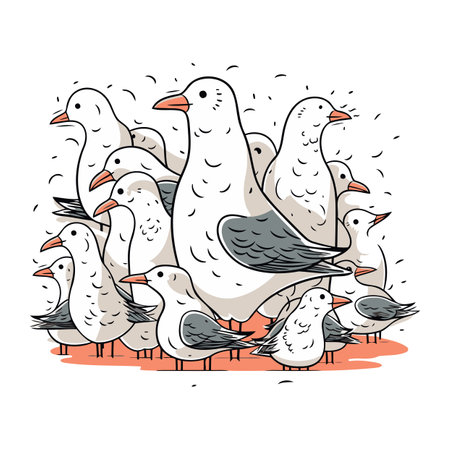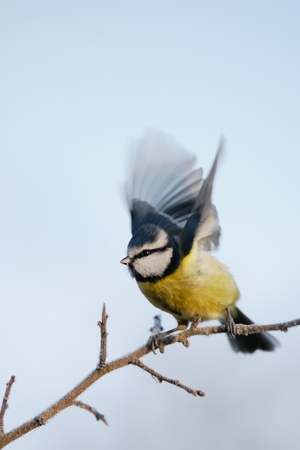Introduction to British Wild Birds
Britain’s wild birds are a cherished feature of the countryside, lending both colour and character to every corner of the landscape. From bustling city parks to tranquil rural hedgerows, these feathered residents provide a gentle soundtrack to daily life, their presence woven into the fabric of local tradition and seasonal rhythm. Each species brings its own unique charm—whether it’s the melodic song of the blackbird at dusk, the cheeky antics of blue tits flitting through cottage gardens, or the stately silhouette of a heron standing sentinel by a village pond. The following table offers a snapshot of some familiar wild birds you’re likely to encounter across Britain, each with its own distinctive traits and preferred habitats:
Common Name |
Distinctive Features |
Typical Habitat |
|---|---|---|
| Robin | Red breast, friendly presence in gardens | Gardens, woodlands, parks |
| Blackbird | Rich, fluting song; glossy black (male) or brown (female) | Hedges, gardens, woodland edges |
| Blue Tit | Vivid blue and yellow plumage; acrobatic feeder | Woodland, gardens, parks |
| Starling | Iridescent sheen; sociable murmurations at dusk | Towns, farmlands, urban rooftops |
| Heron | Tall, elegant stature; patient hunter in shallow water | Ponds, riversides, wetlands |
| Chaffinch | Pale wing bars; cheerful pinkish hue (male) | Parks, woodlands, farmland hedges |
The diversity of wild birds across Britain not only enriches our visual landscape but also fosters a deeper connection to place and season. Observing their behaviours throughout the year invites us to appreciate subtle shifts in nature—a true celebration of British wildlife and its enduring role in our everyday lives.
2. Recognising Seasonal Patterns
British wild birds are deeply attuned to the rhythm of the seasons, and their behaviour shifts in harmony with nature’s changing backdrop. Each season brings a distinct set of cues—alterations in temperature, daylight hours, and foliage—that collectively influence how birds feed, migrate, nest, and interact with their environment. In spring, increasing daylight and milder temperatures signal breeding season for many species. Birds such as robins and blackbirds begin their dawn chorus earlier as days lengthen, marking territories and attracting mates. Summer’s abundance of insects and seeds provides plentiful food, supporting both adult birds and their growing chicks. Come autumn, the shortening days and cooling weather prompt migratory species like swallows to prepare for their long journey south, while resident species focus on building fat reserves. Winter offers its own challenges; reduced daylight limits foraging time, and bare trees make shelter scarce. Birds adapt by flocking together for warmth or seeking out garden feeders stocked by thoughtful homeowners.
Seasonal Influences on Bird Behaviour
| Season | Daylight | Weather | Foliage | Typical Bird Behaviour |
|---|---|---|---|---|
| Spring | Increasing | Mild & Fresh | Budding Leaves | Nesting, Singing, Mating Displays |
| Summer | Longest Days | Warm & Occasionally Wet | Lush Greenery | Feeding Chicks, Territory Defence |
| Autumn | Decreasing | Cool & Breezy | Falling Leaves | Migrating, Fattening Up, Flocking |
| Winter | Shortest Days | Cold & Frosty | Bare Branches | Foraging in Groups, Seeking Shelter & Food Sources |
The British landscape itself acts as a living calendar for our feathered residents. From the first snowdrops piercing through winter soil to the golden hues of autumn leaves carpeting the countryside, these natural shifts dictate not only where birds are likely to be seen but also how they behave. Understanding these seasonal patterns enriches our everyday encounters with wild birds—whether it’s spotting fluffed-up blue tits on a frosty morning or enjoying the melodic serenades that fill a springtime garden.

3. Nesting and Breeding: Spring to Early Summer
As spring unfolds across the British countryside, the air becomes alive with the energetic activity of wild birds entering their nesting and breeding season. This period, stretching from March through early summer, is marked by a remarkable display of instinctual behaviour as birds search for suitable nesting sites, court mates, and prepare for the next generation. For many in Britain, observing these familiar rituals is one of the joys of garden life and countryside walks.
The diversity of nesting strategies among British wild birds is striking. Some species, like robins and blackbirds, choose sheltered nooks in garden hedges or ivy-clad walls, while others such as blue tits favour nest boxes or tree cavities. Meanwhile, wrens often weave intricate domed nests hidden deep within brambles, ensuring protection from predators and the unpredictable spring weather. The following table highlights some common British birds and their preferred nesting habits:
| Species | Preferred Nesting Site | Nesting Material |
|---|---|---|
| Robin | Hedges, sheds, dense shrubs | Moss, leaves, grass |
| Blue Tit | Nest boxes, tree holes | Feathers, moss, animal hair |
| Blackbird | Bushes, low trees | Mud, grass, twigs |
| Wren | Bramble thickets, crevices | Moss, feathers |
For those tending to gardens or strolling along rural hedgerows during this time, its not uncommon to catch sight of busy parents-to-be darting back and forth with beaks full of twigs or hear the persistent callings of males defending their territory. In suburban neighbourhoods across Britain, nest boxes have become an essential feature—offering safe havens for cavity-nesting species and bringing the magic of nature right to our windowsills.
4. Migration Movements
Among the most remarkable seasonal behaviours witnessed in Britain’s wild birds is the grand spectacle of migration. Each year, millions of birds undertake epic journeys, traversing continents and seas to exploit the changing resources of the British countryside. These movements are not only a testament to the resilience and navigational prowess of our avian visitors and residents, but also form an integral part of Britain’s natural heritage.
Arrival and Departure Timings Unique to Britain
The timing of these migrations is a carefully orchestrated phenomenon that hinges on both environmental cues and genetic programming. Birds such as the Swallow (Hirundo rustica) herald the arrival of spring, typically making their appearance from late March through early April, after an astonishing flight from sub-Saharan Africa. Meanwhile, autumn sees the departure of species like the Swift (Apus apus), which leave our shores by early August to avoid the impending chill.
Key Migratory Species and Their Schedules
| Species | Spring Arrival | Autumn Departure |
|---|---|---|
| Swallow | Late March – Early April | September – October |
| Cuckoo | Mid-April | July – August |
| Swift | Early May | Early August |
| Redwing & Fieldfare (Winter Visitors) | October – November (arrival) | March – April (departure) |
| Barnacle Goose | October (arrival) | April (departure) |
The Role of British Habitats in Migration Patterns
The unique tapestry of Britain’s wetlands, woodlands, and coastal marshes provides essential stopover sites for refuelling during migration. Many sites, such as the Norfolk Broads or Morecambe Bay, become temporary homes for thousands of waders and waterfowl. The ebb and flow of these migratory populations not only shape local ecosystems but also offer a rhythm to rural life that is distinctly British—a gentle reminder of nature’s cycles woven into everyday experience.
5. Foraging and Feasting: Dietary Changes
The British countryside is an ever-changing larder for wild birds, shaped by the rhythm of the seasons. As temperatures rise in spring, the earth softens and rainfall tempts worms and insects to the surface—an irresistible feast for robins, blackbirds, and thrushes. With an abundance of protein-rich fare, many birds can fuel the energy-intensive demands of nesting and rearing chicks. In contrast, the bounty shifts with summer’s arrival; fields and hedgerows burst with caterpillars, beetles, and other invertebrates, providing a rich buffet for tits and warblers. By autumn, wild birds must recalibrate their diets once more. The British landscape transforms into a tapestry of ripening berries, seeds, and nuts. Migratory species like redwings and fieldfares flock to hawthorn bushes, while finches and sparrows turn their attention to seed heads in meadows and gardens.
Seasonal Diet Shifts Among Common British Birds
| Season | Main Food Sources | Notable Bird Species |
|---|---|---|
| Spring | Worms, insects | Robins, Blackbirds, Thrushes |
| Summer | Caterpillars, beetles, spiders | Tits, Warblers, Swallows |
| Autumn | Berries, seeds, nuts | Redwings, Fieldfares, Finches |
Adaptation at Home: Supporting Seasonal Diets
Gardeners across Britain often lend a helping hand by topping up bird feeders or leaving windfall apples beneath trees as the colder months approach. Choosing native plants that fruit at different times of year not only enhances your garden’s beauty but also ensures a continuous food supply for visiting wildlife. Observing these seasonal shifts can be both an aesthetic delight and a practical cue for which treats to offer your feathered guests.
Aesthetics Meets Functionality
The interplay between wild birds’ changing diets and our outdoor spaces invites us to embrace a more mindful approach to garden design—one that honours nature’s cycles while adding charm to our daily routines.
6. Winter Survival Strategies
As the British winter settles in, wild birds face a period of challenge and adaptation. The frosty mornings, short daylight hours, and scarce natural food sources require both ingenuity and resilience. It’s during these colder months that we see some truly remarkable survival behaviours among Britain’s feathered residents.
Resourceful Use of Feeders
In towns and countryside gardens alike, bird feeders become vital lifelines. Species such as robins, blue tits, and great tits quickly learn to rely on the steady supply of seeds, suet balls, and peanuts provided by keen bird lovers. This mutual relationship not only supports wild bird populations through lean times but also brings a flurry of activity to even the quietest British garden.
Types of Food Favoured at Feeders
| Bird Species | Preferred Winter Food |
|---|---|
| Robin | Mealworms, Sunflower Hearts |
| Blue Tit | Peanuts, Suet Pellets |
| Blackbird | Fruit, Raisins |
| Goldfinch | Niger Seeds |
Shelter in Gardens and Hedgerows
Beyond nourishment, shelter is crucial for birds braving wintry British weather. Dense hedgerows, ivy-clad fences, and purpose-built nest boxes offer protection from icy winds and predators. Well-established British hedgerows are especially invaluable: their tangled branches provide roosting sites and a degree of warmth after sunset.
Popular Garden Shelters for Birds
| Shelter Type | Benefits During Winter |
|---|---|
| Ivy-covered Walls | Insulation & Camouflage |
| Mature Hedges (e.g., Hawthorn) | Safe Roosting Spots |
| Nest Boxes | Sheltered Sleeping Quarters |
| Shrubs & Evergreens | Wind Protection |
A Reflection on British Gardens as Sanctuaries
The quintessential British garden—complete with feeders, dense shrubbery, and old hedgerows—acts as a haven for wild birds during the harshest season. By providing food and shelter, householders across Britain play an essential role in helping native species navigate winter’s challenges. In turn, birds reward us with their presence and song—reminding us that even in the heart of winter, our outdoor spaces can be full of life.
7. Everyday Encounters: Appreciating Birds at Home
Observing wild birds from the comfort of your British home, whether in a city flat with a window box or a country cottage surrounded by hedgerows, is an everyday luxury that invites mindfulness and gentle connection to the rhythms of nature. As the seasons shift, so too do the sights and sounds of our feathered neighbours. By adopting simple, thoughtful practices, you can both support local birdlife and cultivate moments of quiet joy.
Practical Tips for Bird Observation
Set up a designated viewing spot—perhaps by a kitchen window overlooking your garden or allotment. Keep a pair of binoculars and a British bird guidebook handy for quick reference. Take note of visiting species, their seasonal plumage changes, and distinctive calls. Early mornings and late afternoons are often best for sightings.
Mindful Support: Nurturing Your Local Birds
| Season | Supportive Actions | Typical Bird Behaviour |
|---|---|---|
| Spring | Install nesting boxes; provide fresh water; avoid heavy pruning. | Nesting, courtship displays, territory singing. |
| Summer | Maintain bird baths; offer mealworms and fruit; ensure shade. | Feeding young, moulting, seeking cool spots. |
| Autumn | Leave seed heads uncut; scatter autumnal berries; tidy up only part of the garden. | Migratory preparations, flocking behaviour, increased foraging. |
| Winter | Provide high-energy foods (fat balls, suet); break ice on water bowls; shelter with evergreen shrubs. | Foraging in groups, roosting for warmth, using feeders more frequently. |
Cultivating Connection With Nature at Home
Create small rituals—such as morning tea paired with five minutes of quiet birdwatching—or involve children in keeping a seasonal bird diary. Share observations with neighbours or local wildlife groups to build community around nature appreciation. These mindful encounters help foster respect for Britains avian life while enriching daily home routines with beauty and meaning.


